The History Of BMW 328I

The BMW 3 Series is an entry-level luxury car/ compact executive car manufactured by the German automaker BMW since May 1975. Successor to the 2002 coupe, it has been produced in five different generations and in no less than five different body styles. It is BMW's best selling automobile, accounting for nearly 40% of the company's auto sales in 2005.
BMW released its E21 in the wake of the 1973 oil crisis, attracting customers seeking both prestige and economy, nearly doubling BMW's worldwide auto sales figures in three years, and winning numerous automotive world awards and honors. Three decades later, the 3 Series' E46 was the best-selling of its class,as commonplace in Asia and America as in Europe, while maintaining its prestigious brand and image.
The 3 series has also maintained BMW's racing heritage. The M version of the 3 series, M3, debuted in the 1980. Marketed as a daily driver and a track ready race car, M3's popularity as a sports sedan raised customer awareness of the 3 series brand.[citation needed]
3 Series vehicles can be largely differentiated by the underlying platform:
- BMW E21 - (1975–1983) 3 Series
- BMW E30 - (1984–1994) 3 Series
- BMW E36 - (1992–1998) 3 Series
- BMW E46 - (1999–2006) 3 Series
- BMW E90 - (2005–) 3 Series Sedan
- BMW E91 - (2006-) 3 Series Wagon
- BMW E92 - (2007-) 3 Series Coupé
- BMW E93 - (2007-) 3 Series Convertible
The E21 line was produced from May 2, 1975 (1977 in the USA) through 1983. Originally a replacement for the 2002 coupe, the first 3-Series was a 2-door model only. The New Class sedans would be replaced by the 5 Series. A factory authorised cabrio version was built by Baur.
Models:
- for Europe
- 1981-1983 315 - 1.6L M41 I4, 75PS (55kW)
- 1975-1979 316 - 1.6L M41 I4, 90PS (66kW)
- 1980-1983 316 - 1.8L M10B18 I4, 90PS (66kW)
- 1975-1980 318 - 1.8L M42 I4, 98PS (72kW)
- 1979-1983 318i - 1.8L M42 I4, 105PS (77kW)
- 1975-1979 320/ 4 - 2.0L M64 I4, 109PS (80kW)
- 1975-1979 320i - 2.0L M10B20 I4, 125PS (92kW)
- 1979-1982 320/ 6 - 2.0L M20B20 I6, 122PS (90kW)
- 1978-1982 323i - 2.3L M20B23 I6, 143PS (105kW)
- for the rest of world
- 1976-1979 320i - 2.0L M43/ 1 I4, 110hp (82kW)
- 1980-1983 320i - 1.8L M42 I4, 100hp (75kW)
The E30 was sold from 1982 through 1991 in sedan form, through 1993 in convertible form. The E30's introductory price of US$18,210 was nearly double that of the E21 just 7 years earlier, but the availability of a six cylinder engine and 4-door body style (in 1984) earned sales. The torquey "eta" six in the 325e produced 121hp (90kW), but met the strict emission standards of the time. The E30 was the most powerful compact BMW offered in the United States since the 2002 Tii.
The lineup was joined in 1985 by the high-output 325i and 325is. Though the engine displacement was reduced to 2.5L, output was up to 168hp (125kW) as the company focused on performance rather than economy. The rev limit for the new motor was raised from 5000 rpm to 6500 rpm, as a shorter stroke was employed with the new motor.
The 325is was an upgrade from the standard 325i, as some new features were added to the car as standard. These included the full electrics package, BMW sports seats, black roof-liner, BMW M-technic II body kit, BMW 14 inch BBS wheels and a Close Ratio gearbox. Other features also found on the 325is were options, however over time, some have been mistaken for standard features. These options include a Limited Slip Differential (LSD), leather interior, sunroof and BMW 15 inch BBS wheels. Options differed on vehicles produced in the United States.
An all wheel drive version, the 325ix, joined the lineup for 1986. The four-cylinder 318 was dropped in 1985, but was brought back with a new, 1.8L DOHC motor (M42B18) for 1991.
In the end of 1987, BMW introduced the touring version of the E30. It was very popular during its production up to 1994. It was available with a 1.6, 1.8, 2.0 or 2.5 liter engine and also 2.4 liter turbo diesel. The 325ix touring was equipped with 4WD.
The most powerful American BMW E30 in 1989 came in the form of the M3. It used a 192hp (143kW) S14 straight-4 with a 4-valve head adapted from the M88 six and Bosch fuel injection.
Europe:
- 1982-1987 316 - 1.6 L M98 I4, 90 hp (66 kW)
- 1982-1990 316 1.8 - 1.8 L M10B18 I4, 90 hp (66 kW)
- 1987-1993 316i - 1.6 L M40B16 I4, 102 hp (75 kW)
- 1982-1987 318i - 1.8 L M10B18 I4, 105 hp (77 kW)
- 1987-1993 318i - 1.8 L M40B18 I4, 115 hp (85 kW)
- 1989-1991 318is - 1.8 L M42B18 I4, 136 hp (100 kW)
- 1982-1985 320i - 2.0 L M20B20 I6, 125 hp (92 kW)
- 1985-1991 320i - 2.0 L M20B20 I6, 129 hp (95 kW)
- 1988-1990 320is - 2.0 L S14 I4, 192 hp (141 kW)
- 1982-1986 323i - 2.3 L M20B23 I6, 150 hp (110 kW)
- 1985-1991 325i - 2.5 L M20B25 I6, 170 hp (125 kW)
- 1986-1991 325iX - 2.5 L M20B25 I6, 170 hp (125 kW)
- 1986-1988 M3 - 2.3 L S14 I4, 200 hp (147 kW)
- 1989-1991 M3 Evo - 2.5 L S14 I4, 215 hp (158 kW)
- 1985-1991 324d - 2.4 L M21 I6, 86 hp (63 kW)
- 1987-1991 324td - 2.4 L M21 I6, 115 hp (85 kW)
Other markets:
- 1984-1985 318i - 1.8 L M10B18 I4, 101 hp (75 kW) - North America
- 1991 318iS - 1.8 L M42B18 I4, 134 hp (100 kW) - North America
- 1984-1991 325e - 2.7 L M20B27 I6, 121 hp (90 kW) - North America
- 1986-1991 325es - 2.7 L M20B27 I6, 121 hp (90 kW) - North America
- 1987-1991 325i/ is - 2.5 L M20B25 I6, 168 hp (125 kW) - North America
- 1988-1991 325ix - 2.5 L M20B25 I6, 168 hp (125 kW) - North America
- 1988-1991 M3 - 2.3 L S14 I4, 192 hp (143 kW) - North America
- 1984-1990 333i - 3.2 L M30 I6, 197 hp (145 kW) - South Africa
- 1989-1991 325iS - 2.7 L, 197 hp (145 kW) - South Africa
- 1991-1992 325iS - 2.7 L, 210 hp (155 kW) - South Africa
Also known as the "Dolphin shape",[citation needed] The E36 was sold from 1991 through 1999. It employed the "Z-axle" multilink suspension in the rear which had been proven in the Z1. DOHC engines were used widely across the range, with VANOS variable valve timing introduced in 1993.
The four-door E36 was sold from Autumn, 1991 but the E30 coupes were retained until well into 1992. The E36 convertible was delayed until 1994. The hatchback 318ti Compact was introduced in 1995, was not very popular in Europe and even less successful in North America[citation needed]. The Compact was identical to the regular E36 sedan from front bumper to A-Pillar. Everything else was unique, namely its rear semi-trailing arm suspension, based on the old E30, instead of the Z-Axle Multilink employed in all other E36's. The Z3 and M Coupe have similar rear suspension setups as well. The "Touring" station wagon was sold in Europe from 1995.
The 2.5L M50B25 used in the 325i models was replaced in 1996 with the 2.8L M52B28, creating the 328i line. A less powerful 2.5L engine, the M52B25 was sold as 323i rather than 325i.
The 4-door 3 Series models were replaced after 1998 in the US, while the 2-door models lasted through 1999.
Models:
- Europe
- 1991-1995 316i - 1.6L M40B18 I4, 100PS (74kW)
- 1995-1999 316i - 1.6L M43B16 I4, 102PS (75kW)
- 1991-2000 318i - 1.8L M40B18 I4, 115PS (85kW)
- 1992-1995 318iS - 1.8L M42B18 I4, 140PS (103kW)
- 1995-2000 318iS/ ti - 1.9L M44B19 I4, 140PS (103kW)
- 1991-1994 320i - 2.0L M50B20 I6, 150PS (110kW)
- 1995-2000 320i - 2.0L M52B20 I6, 150PS (110kW)
- 1995-2000 323i - 2.5L M52B25 I6, 170PS (125kW)
- 1991-1995 325i - 2.5L M50B25 I6, 192PS (141kW)
- 1995-2000 328i - 2.8L M52B28 I6, 193PS (142kW)
- 1992-1997 M3 - 3.0L S50B30 I6, 286PS (210kW)
- 1995-2000 M3 - 3.2L S50B32 I6, 321PS (236kW)
- 1999-2000 320td - 1.9L M41D17 I4, 136PS (100kW)
- 1994-2000 318tds - 1.7L M41D17 I4, 90PS (66kW)
- 1994-1999 325td - 2.5L M51D25 I6, 115PS (85kW)
- US-only engines
- 1995 M3 - 3.0L S50B30US I6, 240hp (179kW)
- 1996-1999 M3 - 3.2L S52B32 I6, 240hp (179kW)
The E46 chassis began to replace the E36 specification for 1998. Only the 4-door sedans were updated that year. The E36 coupé and touring models lasted one more year until the E46 replacements arrived for model year 2000. The 2.8L cars were called 328 while 2.5L cars got the confusing 323 name. The new M54 engines appeared for 2001; with the new 3.0L 330 replacing the 328, BMW renamed the 2.5L car the 325. Also in 2001, the compact 3-door version appeared on the European market, but it was replaced in 2004 by the 1 series. During the second half of 2005 the E46 sedan and touring were phased out in favour of the new E90. The E46 coupé and convertible remained in production well into 2006. The E46 Coupe & Convertible used a "Ci," standing for coupe/ injection, instead of just "i". The E46 all-wheel-drive (AWD) cars used the "xi" designation to show the cars included BMW's xDrive system
Models:
- Europe and other markets
- 1998-2001 316i - 1.9L, M43TUB19, 105PS (77kW)
- 2001-2005 316i - 1.8L N42B18, 115PS (85kW)
- 1998-2001 318i - 1.9L, M43TUB19, 118PS (87kW)
- 2001-2005 318i - 2.0L N42B20, 143PS (105kW)
- 1998-2000 320i - 2.0L M52B20 T, 150PS (110kW)
- 2000-2004 320i - 2.2L M54B22, 170PS (125kW)
- 1998-2001 323i - 2.5L M52B25 T, 170PS (125kW)
- 1998-2001 328i - 2.8L M52B28 T, 193PS (142kW)
- 2000-2004 325i - 2.5L M54B25, 192PS (141kW)
- 2000-2004 330i - 3.0L M54B30, 231PS (170kW)
- 2000-2003 M3 - 3.2L S54B32, 343PS (252kW)
- 2003 M3 CSL - 3.2L S54B32, 360PS (265kW)
- 1998-2001 320d - 1951cc, 136PS (100kW)
- 2001-2006 320d - 1995cc, 150PS (110kW)
- 1998-2003 330d - 2926cc, 184PS (135kW)
- 2003-2004 330d - 2993cc, 204PS (150kW)
- US-only models
- 1999-2000 323i - 2.5L M52B25 T, 170hp (127kW)
- 1999-2000 328i - 2.8L M52B28 T, 193hp (144kW)
- 2001-2006 325i - 2.5L M54B25, 184hp (137kW)
- 2003-2005 325i - 2.5L M56B25, 184hp (137kW)
- 2001-2004 330i - 3.0L M54B30, 225hp (168kW)
- 2003-2004 330i performance pkg - 3.0L M54B30, 235hp (175kW)
- 2001-2006 M3 - 3.2L S54B32, 333hp (248kW)
The E90 is the currently available generation, which debuted for the 2006 model year, and is available as the sedan (E90), wagon (E91), coupe (E92), and coupe cabriolet (E93). It is completely re-engineered from the E46, including changes to engines, transmission, the passenger compartment, suspension technology, as well as a host of High-Tech features and options. The coupé/ cabriolet body is now its own design and no longer derived from the sedan minus two doors unlike its predecessors, being longer and narrower than its E90 counterpart. The linup received a mid-generational facelift for the 2009 model year.
Currently, four engine options are offered, two being part of the new 'N' series of BMW inline engines featuring a host of new technologies. Technological innovations such as lightweight magnesium/ aluminum construction, electric water pump, Valvetronic (steplessly variable valve lift), and Double-VANOS steplessly variable valve timing all contribute to produce a lighter and more powerful motor than its predecessor, but yield a 15% increase in fuel economy. The E90 also marks BMW's return to Turbo Technology with the introduction of the E92 coupe. The N54 engine produces 300bhp (220kW) and 300lb·ft (410N·m) torque.
The E90 series also marks another first for BMW -- a retractable hard top convertible.
Sales of the E90 have been very strong in Britain. In 2007, a record total of more than 58,000 vehicles were sold and it was the seventh most popular car in Britain.
For the US market, the 2006 model year 325i and 330i are both powered by the same 3.0L N52 engine, but the 330i features revised engine software and improved intake and exhaust systems to produce an additional 40 hp (255 vs. 215). The 2007 model year marks a change to increase the power from the engines, therefore a change to the badging of the vehicles. Canada also gets a 323i sedan which has a detuned 2.5L gasoline-injected inline-six producing 200hp (149kW); the 323i lacks features/ options available to more expensive 3 Series models such as Xenon headlamps, fog lights, automatic climate control, and power-adjustable seats. The new 335i uses a twin-turbo powerplant, also seen on the 1 and 5 series models, and soon to be available on the 6 series model in early 2009.
Engines:
- 316i - 1.6L I4, 122PS (90kW)
- 318i - 2.0L I4, 129PS (95kW), from 2008 143PS (105kW)
- 320i - 2.0L I4, 150PS (110kW), from 2008 170PS (125kW)
- 320si - 2.0L I4, 173PS (127kW), production limited to 2600 units
- 323i - 2.5L I6, 177PS (130kW), exclusive for Australia, Canada and South Africa, from 2008 190PS (140kW)
- 325i - 2.5L I6, 218PS (160kW), in US (and in Europe from 2008)
- 328i - 3.0L I6, 233PS (171kW), not available in Europe
- 330i - 3.0L I6, 258PS (190kW), in Coupé (and sedan from 2008) 272PS (200kW)
- 335i - 3.0L twin-turbo I6, 306PS (225kW)
- M3 - 4.0L V8, 420PS (309kW)
- 318d - 2.0L turbo diesel I4, 122PS (90kW), from 2008 143PS (105kW)
- 320d - 2.0L turbo diesel I4, 163PS (120kW), from 2008 177PS (130kW)
- 325d - 3.0L turbo diesel I6, 197PS (145kW)
- 330d - 3.0L turbo diesel I6, 231PS (170kW), from 2008 245PS (180kW)
- 335d - 3.0L twin-turbo diesel I6, 272PS (200kW), from 2008 286PS (210kW)
The next full revision of the 3 Series is expected in 2012. Updates are reported to include hybrid drivetrain technology .
The 3 Series has been on Car and Driver magazine's annual Ten Best list 18 times, from 1992 through 2009, making it the longest running entry in the list . The E90 was named "Best New Sports Sedan" in the 2006 Canadian Car of the Year awards. Also, it was awarded the World Car of the Year at the New York Auto Show in 2006.
The original E30 M3 is considered one of the most successful race cars ever[citation needed], and is still competitive in several series.
The E36 320d won the 24 Hours Nürburgring in 1998, after the M3 had won in the previous years.
The World Touring Car Championship (WTCC) is one of the FIA's three World Championships (along with Formula One and the World Rally Championship). Andy Priaulx and BMW Team UK won the WTCC in 2005 in an E46 3-series, while the E90 3-series repeated this feat in 2006. The 3-Series' rear-wheel drive layout and design have both been attributed[who?] to its victory, though in Touring Car Racing, as almost every other motor sport, the skill driver and their team tactics are also important.
The 3-Series cars in the British Touring Car Championship (BTCC) and other touring car championships have been penalized under racing rules for being rear-wheel drive and thus having better grip than its front-wheel drive competitors. For example, the 320si has been penalized in the WTCC in previous seasons in order to keep the sport competitive with the rest of the grid (Ford Focus, Chevrolet Lacetti, SEAT Leon, Alfa Romeo 156). Despite these ballast weight penalties, the 320si's of the British, German and Italian/ Spanish teams continually win races and points.[citation needed] However, in the middle of the 2002 European Touring Car Championship (ETCC) season, FIA changed the handicap rules to add an extra 15 kg ballast to front-wheel drive cars (such as the Alfa Romeo 156) and the ballast in rear-wheel drive cars (including BMW) was reduced by 15kilograms (33lb). Today, the WTCC series has a rolling start to eliminate the benefit of better grip that rear-wheel drive cars have from a standing start.[citation needed]
.
The BMW 3-Series is currently used in both the SCCA Pro Racing Speed World Challenge Touring Car Series and the Grand American Road Racing Association Series. In the final 2006 Grand Am standings, BMW finished second in the manufacturer's standings in both the Grand Sport and Street Tuner classes, while E46 BMWs prepared by Turner Motorsport won the driver's and team championships.[citation needed]
From Wikipedia, the free encyclopedia
More About BMW 328I

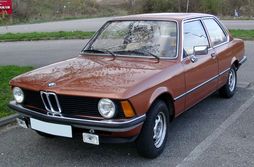
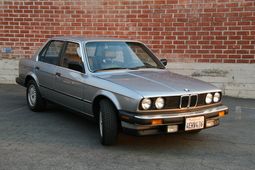
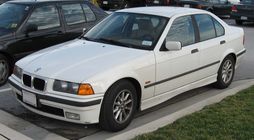

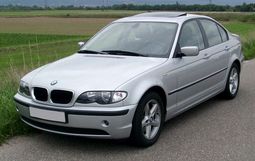
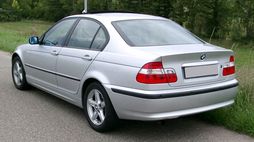

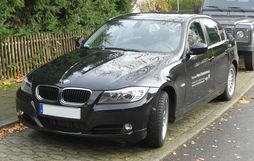
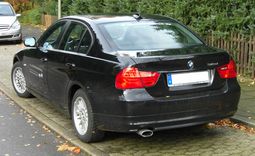
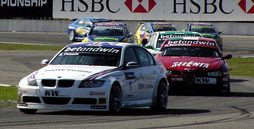
|